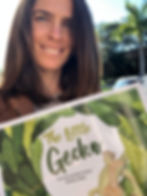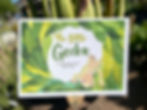TEACHING CHILDREN TO BE BRAVE THROUGH STORIES AND PLAY.
- Life & Style
- May 20, 2022
- 4 min read
Updated: Aug 11, 2022
By Rachel Carey
My sister Rebekah and I have always loved a project together. You know, painting things, decorating things, folding origami cranes for my wedding. That sort of thing. So, I guess it makes sense that when we were all plunged into total lockdown the two of us decided it was a good time to write a story for our children.
There was so much fear at the time. It was all so unknown. This strange virus. Who was safe? How to stay safe. What we were allowed to do. What we weren’t. We wanted to write a story about a character who embodied bravery. We wanted to focus on strength, on courage, on feeling that you are brave and strong enough, even in the face of adversity.

And from this, The Little Gecko was born: a children’s book about a little gecko who sets off on an adventure to find his tail, after losing his when startled by an owl. The book is written in gentle rhyme to support language development and features a bravery affirmation repeated throughout to help children to internalise the message of bravery.
Rebekah did beautiful water colours with superimposed natural features for the illustrations and we toiled over the words together to create a story that both captures imagination but also inspires bravery and self-belief.
The human brain has a negative bias. We are designed to remember the things that feel like threats in our environments. We take note of the bad things, not the good. It’s about survival - we need to know what is dangerous for us. Unfortunately, though, this often makes us believe that things are scarier than they really are.
In the story, when gecko needs to have courage, he brings to mind all the challenges he has overcome already; he reminds himself of the good, of his successes, where he was strong. And it is in doing this, that he finds his strength and bravery.
It is so important to teach children the skill of doing this; of focusing on their wins in life, of reminding themselves what they have achieved, how far they have come. The Little Gecko book is a lovely introduction to this process.

As a children’s occupational therapist I am so aware of how children are primarily sensory learners and how it is really through their bodies that they learn best. The connection with their bodies and their sensory systems is completely linked to self- regulation - a vitally important aspect of bravery.
Bringing the characters in the story to life for children, in the form of yoga poses, seemed like the natural progression of the book. I have collaborated with the wonderful, talented local yoga teacher and mum, Helen Garner to do just this.
As adults, we use yoga as a form of mindfulness and movement meditation in which we can become aware of our bodies and connect with the present moment. We do this through our external and internal sense systems. These systems working smoothly are vitally important for sensory regulation which goes hand in hand with our emotional regulation. Children learn through play. For new synapses to be formed in the brain, neuroscientists hypothesise that we need up to 400 repetitions of an action. If children learn spontaneously in play however, the number of repetitions can be reduced dramatically to about 10 to 20 repetitions with the same outcome. Perhaps more importantly, evidence shows that when children learn through spontaneous play, they are able to generalise the skills they learn far better than when they learn through drill-like, staged repetitions.
Play is the language of learning for children and so the challenge for us was to create a yoga programme, that would include the regulatory sensory input as well as the strength and developmental goals yoga offers, while being fun and playful. Bringing the characters from the story to life allows us to do just that.
We held our first children’s yoga holiday club during the last school holidays, and it was a great success. Watching these little children across the three days of the club, internalise the affirmation, become more aware of their bodies and their movements, and learn breathing and sensory techniques for helping them calm and regulate, was rewarding beyond measure.
We are now planning a series of stories that can accompany our children’s yoga courses. The first of the series being the little gecko with the social emotional attribute of bravery at the core of the story.The characters he meets along the way are all included in the yoga course as postures and each offers characteristics that allows us to work on different developmental skills.
From balance, through to using both sides of the body together in a synchronised way, from dissociating our head and eye movements through to weight bearing through our upper limbs for better shoulder stability - these are all foundation skills that we work on in OT and which children need to learn and practice playfully to be successful at school and with the demands of the classroom.

What started out as a small project with my sister and I, for our own children, has grown organically into this beautiful gift that we can offer all children in the form of these stories and the yoga courses that go with them.
I’m not going to lie, it’s daunting, and at times I feel a little overwhelmed to think I’ve somehow become a children’s author and children’s yoga programme developer. But then, like little gecko, I remember that I am brave and strong enough and I keep going.
The Little Gecko
Teaching Children to be Brave Through Stories and Play
@yo.t_kids








